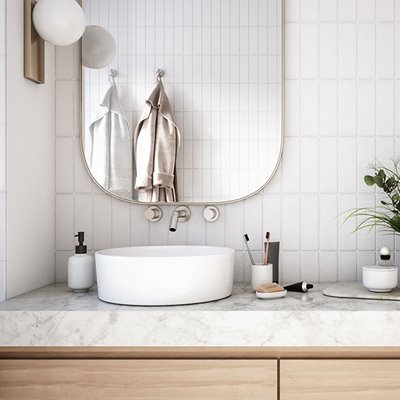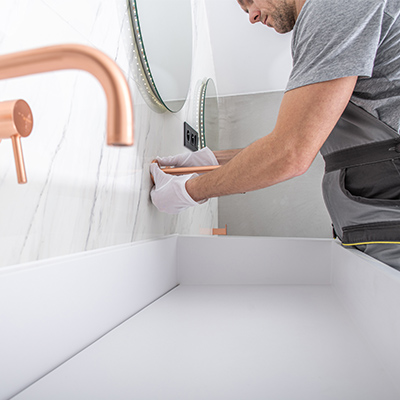WHAT HOME RENOVATION PROJECT ARE YOU MADE READY TO TACKLE?
Stop fantasizing about the home of your dreams and start exploring the resources you need. They’re all here — articles, checklists, strategies and more. You’re made ready to make your dream home renovation a success. And a Home Equity Line of Credit (HELOC) can help you fund your home improvement goals.
Make a plan
The first hurdle you need to clear before jumping into a bathroom renovation is to determine if you want a partial or a full update.
Choose an option
Partial Renovation
Full Renovation
Back
Partial Renovation
If you’re just planning on a lighter upgrade, allocate your funds to the areas that would get you the most bang for your buck:
- New plumbing fixtures: While old fixtures can date a room, new ones make your bathroom more updated and inviting.
- Vanity upgrade: Marble and granite are top picks for countertops, as they look modern. Conversely, tile and plastic-coat can make your bathroom look old-fashioned.
- Fresh coat of paint: Bathrooms are more likely to endure mildew growth and water damage. Purchasing mold- and mildew-resistant paint can help prevent this issue. Be sure to check for any mildew or water damage prior to painting.
- New floor: Flooring can completely change the look and feel of your bathroom for less than $4 per square foot.
- Energy efficient upgrades: Low flow optimizations means less water usage and a lower water bill. Saving energy matters to buyers these days.
Back
Full Renovation
Start by deciding on a floorplan. It’s best to consult with a builder who can explain to you the practicalities of each layout option. For example, they’ll know if positional changes of bathroom fixtures would likely affect your plumbing and increase the cost.

Quick tip
The largest expense is installation/labor. You can reduce labor costs by determining if there are aspects of the job you can manage yourself (be realistic).
As for bathroom cabinetry, fixtures, flooring, and lighting, shopping around can offer significant savings. You’re likely to find a better deal searching and comparing your options than by having your contractor order materials without your input.
Create a budget
What renovations are you tackling? Use this renovation checklist to create yours.
SO YOU WANT TO RENOVATE YOUR BATHROOM …
This may feel like the right time to renovate your bathroom, but there are several factors you need to consider if you want your home renovation project to be successful:
Discuss the practicalities of each layout option with a qualified builder.
Allocate your funds to the areas of the home that would get a higher return.
Cut down on labor costs by tackling some of the work yourself.
You can find significant savings.
Letting home maintenance slide may cost more than a reno.
Bathroom renovations offer a 60% ROI and score high on the Joy Score.

Are you thinking of refinancing or selling down the road? Contractors are currently in high demand and face both material and labor shortages that can result in delays and higher prices. However, given the hot housing market, the effort may be worth it if you intend to sell and the upgrades increase the value of your estate.
If your intention is to improve your quality of life and this is your “forever” home, the time may be right for a reno, as borrowing costs are low. Most importantly, you’ll want to start enjoying your new bathroom as soon as possible.
Is now the right time? Apply for a HELOC with Citizens today!
Is now the right time?
Regardless of your budget, a good starting point is to fix what’s broken first. Over time, letting home maintenance slide could cost you much more than a reno. If you have broken fixtures or aged plumbing or electrical systems, these should be prioritized as you weigh your renovation options.


Drag the slider back and forth to see what before and after could look like for you!
Other financial considerations
It’s unlikely you’ll ever get a 100% return on home improvements if your plan is to resell.
However, bathrooms offer the second best return of investment (ROI) of all major renos (kitchens are #1), at about 60 percent.

1. DIY
2. Keep the same layout
3. Shop smart

1. DIY
The largest portion of your budget (20%) will likely be labor costs. Talk to your contractor about what you might be able to DIY — safely. Even if you’re not particularly handy, taking a sledgehammer to that ugly tile that’s haunted you since you moved in is my idea of a good time. Demolition, disposal, and painting are all examples of things you can do yourself to help cut costs.
2. Keep the same layout
3. Shop smart

1. DIY
2. Keep the same layout
Functionality is arguably one of the most important considerations when taking on a bathroom renovation project. If your current bathroom works for you and your family, consider whether moving the bathtub to where the sink used to be is a “nice to have” or a “must have.” Changing the layout comes with some pricey plumbing, so keeping the same footprint will help keep your budget on track.
3. Shop smart

1. DIY
2. Keep the same layout
3. Shop smart
When it comes to choosing fixtures and countertops, shop around to find the best prices. Think about nontraditional materials that are cheaper, look great, and work for your space. You may be able to save by buying direct versus having your contractor order materials for you. Additionally, if you’re not afraid of a fixer-upper, flea markets and salvage yards offer great finds that may be perfect for your design — and cost a fraction of the price.
Personal happiness
Bathroom renos are highly rated in the “Joy Score” (this is the level of enjoyment homeowners experience when they’re in a more aesthetically pleasing, functional space). In fact, according to the National Association of Realtors, bathrooms score 9.6 out of 10. Happiness is one thing, but the main reasons homeowners prioritize a bathroom reno over other options is more practical: wear and tear and functionality.
Where do you score yourself? Use the slider to let us know.
This bathroom
has to go!
Hm, I'm OK
with my bathroom
I have the
perfect bathroom!
Using a HELOC for your renovation
A
is a line of credit that uses your home as collateral.
The amount you can borrow is based on the value of your home, minus your mortgage(s). As you pay it off, your home gains equity, which you can then leverage using a HELOC to fund a home renovation.
Quick tip
A HELOC often has a lower interest rate than other financing options, so it can be a big advantage for homeowners. The credit is available to you over the borrowing or draw period, which is typically 10 years. An added bonus? You’re only required to make monthly interest payments on the money that you actually borrow.
